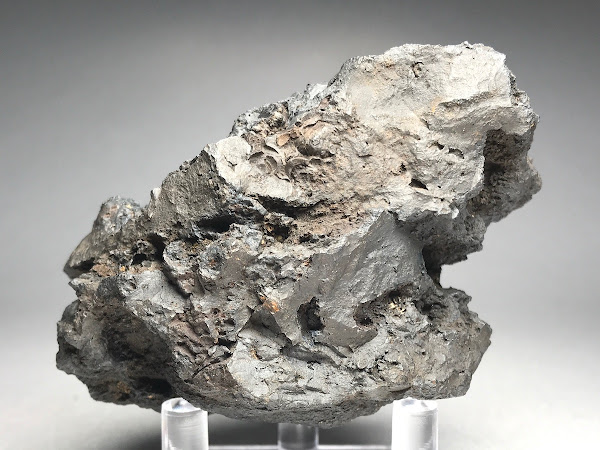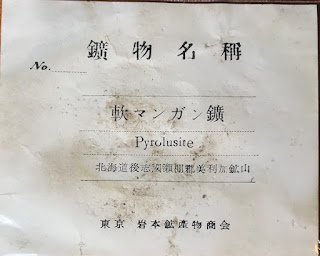今金町のマンガン鉱とめのう Manganese Ore and Agate from Imakane
軟マンガン鉱 Pyrolusite
北海道南西部から東北北部(とくに岩手県)には多数のマンガン鉱山があった。鉱石鉱物は菱マンガン鉱、ハウスマン鉱、バラ輝石など、それぞれの鉱床によって異なるが、ここ美利河(ピリカ)鉱山では黒色の酸化マンガン鉱が主たる鉱石だった。ラベルによるとこの標本は軟マンガン鉱(パイロルース鉱 MnO2)。れっきとした自形結晶こそみられないが、表面の光沢は光を反射して白っぽくみえるほどで、なかなか立派なものだ。美利河では他にもカリウムを含んだクリプトメレーン鉱(KMn8O16)や水マンガン鉱(MnO(OH))などが見られたが、土状・塊状のものは見た目が似ている場合が多く、一般に識別はむずかしいとされる。
There were many manganese mines in the southwest Hokkaido to the north Tohoku (especially Iwate) area. The deposits were characterized by their own ore minerals such as rhodochrosite, hausmannite, and rhodonite. The Pirika deposit was mainly composed of black manganese oxides. This photo shows an example of pyrolusite (MnO2), which is relatively crystalline with a dull metallic luster. Other ore minerals were cryptomelane (KMn8O16) and manganite (MnO(OH)).
めのう Agate
標本幅 width: 5.8 cm / 重さ weight: 107 g
美利河鉱山は現在の美利河ダムの北側にあったが、そこから下流に数 km ほどの花石地区にはめのうの産地が点在している。石英のごくごく細かい結晶が集合して塊状になったものを玉髄といい、そのうち紅色だったり縞模様になっていたりする「美しい」ものをめのう(瑪瑙)という(たとえば堀秀道「楽しい鉱物図鑑」)。さまざまな装飾品や工芸品に加工され、また硬くて大塊が手に入りやすいので乳鉢にもつかわれる。花石のめのうは明治初頭から生産がはじまり、19世紀末には国内生産の 95 % を占めていたというから、このあたりの町のにぎわいも相当だったろう。良鉱の枯渇により1980年代には採掘を終えたという。
Hanaishi, about several kilometers south of the Pirika mine, is known to have produced agate. Having started at the beginning of the Meiji period, Hanaishi occupied 95% of the national total agate production at the end of the 19th century. The mining business ended in 1980s.
参考
-
今金町教育委員会 > 文化財の保護 > いまかね文化財マップなど。このあたりは砂金の産地としてもしられていて、江戸〜明治にかけての砂金採取地跡が点在する。
This area is also known to be a locality of placer gold.
-
史跡ピリカ遺跡。もっとさかのぼると、いまから1〜2万年前の旧石器時代にはここに石器の一大生産拠点があったことが、大量に出土する石器等から推定されている。おもに硬質の頁岩でつくられているが、一部は地元産出のめのう製や道内の他産地の黒曜石製もある。まったくもってこの地の人々は地下資源とともに歩んできた、といえよう。
Numerous stone tools excavated in Pirika suggest that there was a big stone-tool factory in the Old Stone Age (about ten to twenty thousands years ago). The tools were made of shales, agate and obsidian. People in Pirika and Hanaishi area lived with earth's resources at any times.
-
土居繁雄「今金地域のマンガン鉱床」(北海道地下資源調査所報告 No.20 1958年)。ピリカ鉱山では層状のマンガン鉱が「虎石」と呼ばれる黄褐色〜黒色・暗緑色の緻密な珪質岩と接しているケースが多かった。虎石の中に伴われているマンガン鉱石はここで紹介した標本のように緻密、堅硬なものが多く、金属光沢を示すという。
-
山田英春氏の花石産めのうのコレクション(「Lithos-Graphics」 > 「世界の瑪瑙図鑑」)。これはすばらしい。
Yamada Hideharu's collection of Hanaishi Agate (in Agates of the World in Lithos-Graphics). This is the true Hanaishi agate!
-
和田八重造、粟津秀幸「原色日本鉱物図譜」(1936年)より「瑪瑙加工順序」。写真の瑪瑙は「北海道余市郡玲古辺産」とあるが、おそらく現在の花石地区の珍古辺川周辺のものだろう。
- 選ばれた良品の原石。
- 適当の大きさに割りたるもの。
- 瑪瑙を加熱し、含有している鉄分をして赤色酸化鉄に変じさせ赤色をつける。
- 適当の大きさに割る。一度加熱した瑪瑙は、生瑪瑙に比し、やや脆ければ加工に容易となる。
- 荒仕上げ。帯留めの形。
- できあがり彫刻品。





